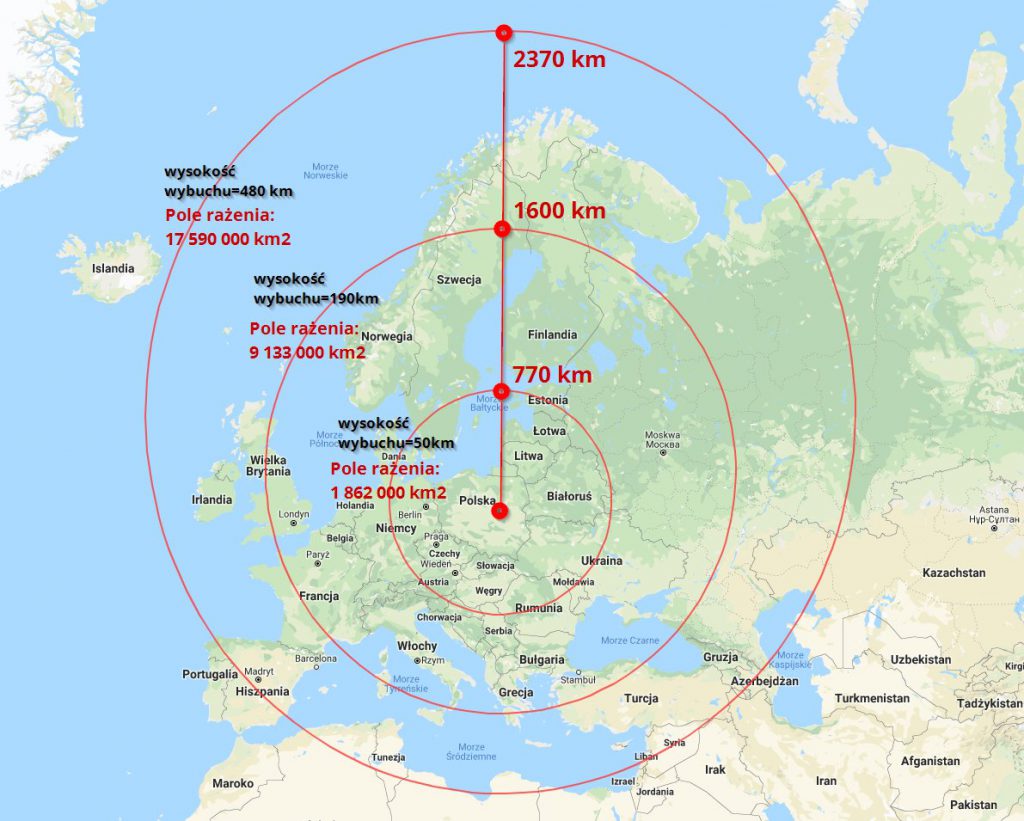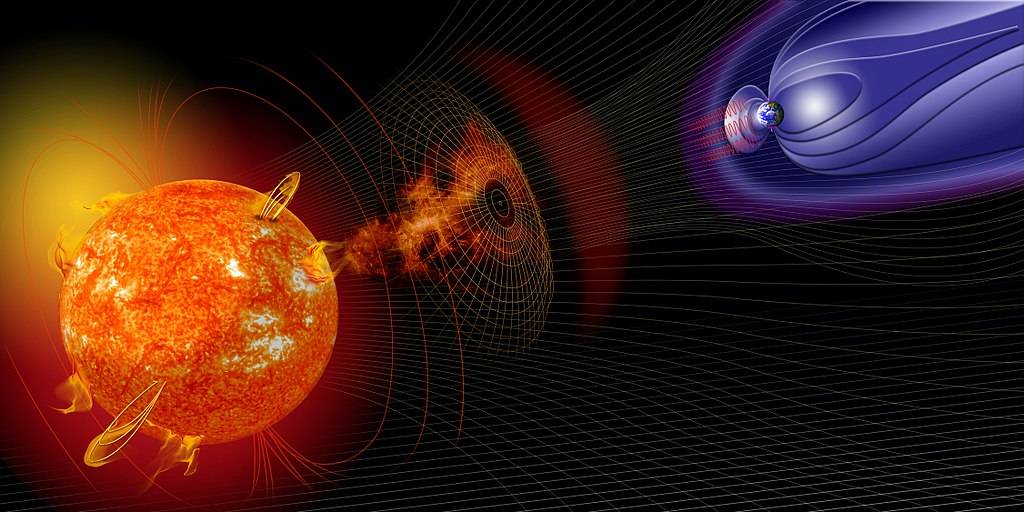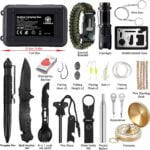- 1 Technology is an inseparable part of our lives
- 2 What if … ?
- 3 What is an EMP and where does it come from?
- 4 Nuclear ElectroMagnetic Pulse (NEMP)
- 5 The best-known military incident involving an EMP electromagnetic pulse
- 6 Coronal mass ejection (CME)
- 7 Electromagnetic storms are nothing new – we were lucky
- 8 How do you protect yourself and your equipment from an electromagnetic pulse (EMP)?
- 9 How do I make a Faraday cage myself?
- 10 What firing an EMP means for people
- 11 Always be forewarned
Did you know that the world we live in and know can be annihilated by a single and sufficiently powerful electromagnetic pulse? In this article you will learn how this is possible.
Technology is an inseparable part of our lives
Our civilisation has been thousands of years in the making. From ancient times until today, mankind has done a tremendous amount of work. Building on the achievements of previous generations, we have created a whole host of tools and solutions that make our lives easier. Over the last 100 or 200 years, technological progress has accelerated significantly – and is still accelerating. Sometimes I even get the feeling that the pace of this progress is too fast to keep up with.
We are currently experiencing a so-called technological revolution. The entire so-called Western civilisation, is based on advanced technology that controls (and will increasingly control), almost every aspect of our lives. We have computers, mobile phones, televisions, cars, GPS, fridges and a whole host of other things without which we cannot imagine normal life.

Pictured is the AMD 5600X 6 x 3.7 GHz processor
There can be up to several billion transistors in one. On the one hand, this is an incredible achievement; on the other hand, such technological packing makes modern electronics very unresistant to various external factors, such as electromagnetic radiation.
Modern technology gives us convenience and safety, but is unfortunately not without its weaknesses. The entire structure that is modern civilisation, on which we are more or less dependent, is built in the shape of a pyramid, at the top of which is electricity. Without it, practically from one day to the next, we lose all the achievements of technology, and our lifestyle – if we survive – will have to change dramatically.
I also touched on a very similar subject in the article Are we facing blackouts in Poland? How to survive without electricity?
What if … ?
Try to ask yourself: what would happen if the electricity was switched off today and not switched on for the next days, weeks, months or maybe even years? Would you be able to cope? Where would you get drinking water from? How and where would you store food? How would you contact loved ones or call for help if needed?
If you think that cutting off the electricity over a wide area is very unlikely, I have to worry: it is not only possible, it is very likely. This is all thanks to a so-called electromagnetic pulse, otherwise known as an EMP (ElectroMagnetic Pulse).
What is an EMP and where does it come from?
AnEMP is a short pulse of electromagnetic energy which can be caused by a natural or man-made phenomenon. Depending on the source, it may be radiation, electric or magnetic radiation.
We encounter various types of electromagnetic impulses on a daily basis. An electromagnetic pulse is, for example, lightning and various other forms of electrostatic discharge. Electromagnetic pulses are also generated by electric motors and ignition systems of internal combustion engines.

Seemingly, then, it appears that electromagnetic pulses are everywhere and are not dangerous to us. This is only partly true, because some electromagnetic pulses are extremely powerful and are capable of destroying electronic and electrical equipment and the infrastructure of the electricity transmission network.
In this text, I would like to focus on the two most dangerous sources of electromagnetic pulse.

Nuclear ElectroMagnetic Pulse (NEMP)
Three types of electromagnetic pulse are generated during a nuclear explosion, which follow one after the other:

E1 – The E1 electromagnetic pulse is a very fast EMP pulse produced during a nuclear explosion. E1 is a briefly occurring but intense electromagnetic field that induces high voltages in electrical wires. E1 is responsible for damaging electronic and electrical equipment by causing an electrical breakdown voltage to be exceeded. E1 can damage computers and communication equipment and changes too quickly (nanoseconds) for ordinary surge protection systems to provide effective protection against it. However, fast-acting surge protectors (such as those using TVS diodes) are able to effectively block the E1 pulse.
E2 – The E2 electromagnetic pulse is a medium-length pulse that lasts from about one microsecond to one second after the burst. E2 has many analogies to lightning, although the E2 pulse caused by lightning, can be much stronger than that caused by a nuclear explosion. Because of the similarities and the widespread use of lightning protection technology, E2 is generally considered to be the easiest to control. However, according to the United States EMP Commission, the main problem with E2 is that it immediately follows E1, which may have previously damaged equipment that would normally protect against E2.
E3 – The E3 electromagnetic pulse is different from E1 and E2. E3 is a much slower pulse, lasting from tens to hundreds of seconds. This is due to the temporary distortion of the magnetic field by the nuclear detonation. The E3 pulse has similarities to a geomagnetic storm caused by a solar flare. Like a geomagnetic storm, E3 can produce induction currents in long electrical cables, damaging their components such as power line transformers. Because of the similarity between solar-induced geomagnetic storms and the E3 pulse, it has become common to refer to solar-induced geomagnetic storms as “Solar EMPs”. “Solar EMP”, however, does not include E1 and E2 pulses.
Many experts believe that some nuclear weapons are designed to maximise the effect of the electromagnetic pulse. For military applications, the most effective method of using a nuclear electromagnetic pulse, is detonation in the higher layers of the atmosphere. When the explosion takes place more at an altitude of 20 to 40 km and higher above the earth’s surface, we are no longer talking about an EMP but a HEMP.
While with a ‘normal’ nuclear explosion, such a high altitude is not advisable (due to reduced shock and heat wave effects and less radioactive fallout), it is a very effective tactic when flaunting an electromagnetic pulse. Thus, the pulse can cover a huge area. Of course, the strength of the pulse decreases with distance, but even a weakened pulse is capable of causing serious damage.

Many armies also have smaller EMP generators that can be carried by missiles, aircraft or ground vehicles. However, the explosive power of such devices is many times less than nuclear explosions. However, this has its advantages: it allows for a more precise delimitation of the effective field of action and for point-to-point attacks against the enemy, disabling only vital infrastructure.
The best-known military incident involving an EMP electromagnetic pulse
While it is not entirely clear whether the technology used in the attack was based on EMP or rather on jamming and disrupting enemy radio signals, the unmistakable significance of this incident is clear and should give any reasonable person pause for thought. Although there are many indications that the whole story was fabricated by Russian intelligence, I nevertheless think it is worth quoting.
Background to the plot
on 10 April 2014, the destroyer USS Donald Cook entered the waters of the Black Sea, and on 12 April, a Russian Su-24 tactical bomber, flew over the ship triggering an incident that, according to several media reports, completely demoralised its crew, so much so that the Pentagon issued an official protest.
The main character of the
The USS Donald Cook, is a fourth-generation guided missile destroyer whose key weapons are Tomahawk cruise missiles with a range of up to 2,500 km, capable of carrying nuclear warheads. The ship carries approximately 150 Tomahawk missiles. The US destroyer is also equipped with the latest Aegis combat system. This is an integrated naval weapons system that can link the missile defence systems of all ships embedded in the same network to ensure detection, tracking and destruction of hundreds of targets at the same time.
In addition, the USS Donald Cook is equipped with four large radars whose power is comparable to that of several ground stations. For its own protection, it carries more than fifty anti-aircraft missiles of various types.
Protagonist
Meanwhile, the Russian Su-24 that devastated the USS Donald Cook had neither bombs nor missiles, but only a basket mounted under the fuselage which, according to the Russian newspaper Rossiyskaya Gazeta, contained a combat device called Khibiny.
Incident
As the Russian jet approached the US ship, the Khibiny disabled all radars, control circuits, systems, information transmission, etc. aboard the US destroyer. In other words, the all-powerful Aegis system, was cut off and switched off, as easily as you switch off a TV with the remote control.
The Russian Su-24 then simulated a missile attack on the USS Donald Cook, which was literally deaf and blind at the time. As if in an exercise, the Russian aircraft – unarmed – repeated the same manoeuvre 12 times before flying away. Then, the state-of-the-art US fourth-generation destroyer immediately sailed off towards a port in Romania.
Implications
Since this incident, which the Western media has carefully covered up and concealed (I have found it very difficult to find information on it, even though the case was quite widely reported at one time), despite widespread reassuring reactions and comments from defence industry experts, no US ship has ever approached Russian territorial waters.
According to some media reports, 27 sailors from the USS Donald Cook asked to be released from active duty. They must have experienced considerable trauma.
Epilogue
Vladimir Balybine – director of the electronic warfare research centre at the Russian Air Force Academy – commented on the event as follows:
“The more complex a radio-electronic system is, the easier it is to disable it with electronic warfare”.
Did the story really happen, or is it more a product of the Russian propaganda machine? It is hard to judge, but it is almost certain that such events are as possible.
Coronal mass ejection (CME)
In 1859, an event occurred that should serve as a warning and a cautionary tale. A powerful solar storm took place, the effects of which have been forever consigned to history. on 1-2 September of that year, a so-called coronal mass ejection hit the Earth’s magnetosphere and caused one of the largest recorded geomagnetic storms. Triggered by this phenomenon, a flare in the solar photosphere was observed and recorded by British astronomers Richard C. Carrington and Richard Hodgson and in the English-language literature functions as the Carrington event, or Carrington event.

Solar EMP triggered global atmospheric anomalies
During its duration, auroras were seen all over the world – those from the northern hemisphere reached as far as the Caribbean. Flashes in the Rocky Mountains in the United States were so bright that the glow woke up miners, who began preparing breakfast because they thought it was morning.
People in the northeastern United States were able to read the newspaper by the light of the aurora. The aurora was visible from the poles to an area such as south-central Mexico, Queensland, Cuba, Hawaii, southern Japan and China, and even at lower latitudes very close to the equator, for example in Colombia.
Destroyed telegraph network infrastructure
Telegraph systems across Europe and North America failed, in some cases their operators were electrocuted. Some telegraph equipment produced sparks. Some telegraph operators were still able to send and receive messages even though the power supply equipment was not working.
If a solar storm of this magnitude were to occur today, it would cause widespread electrical disruption, blackouts and massive damage due to prolonged power outages. In June 2013, scientists used data from the 1859 event to estimate the current cost of a similar event in the US alone at US$0.6-2.6 trillion!
Electromagnetic storms are nothing new – we were lucky
Smaller solar storms occurred in 1921 and 1960, there was widespread radio interference then. A geomagnetic storm in March 1989, destroyed the power grid in large sections in Quebec, Canada.
on 23 July 2012, a solar storm of similar strength to that of 1859 was observed, but the electromagnetic wave diverged from the earth by some 9 days (!).

How do you protect yourself and your equipment from an electromagnetic pulse (EMP)?
It is highly likely that a strong enough electromagnetic pulse, is capable of damaging any electrical device. Different devices show different resistance to the electromagnetic pulse, but almost all are susceptible to it. It may be interesting to note that old electron vacuum tubes can withstand electromagnetic pulses very well. However, this does not mean that they are completely immune. Modern electronics, for example computers, hard disks and telephones, are very susceptible to this type of damage.
Protect your devices – the Faraday cage
So what can we do to protect our electronics and electrical devices from the destructive force of an electromagnetic pulse? The best protection for such a circumstance, which each of us can make on our own, is the so-called Faraday cage, which has been known to science for a long time. I will not go into the details of how it works here, because it is not very important. And many of us probably still remember it from school.
On the practical side, it is enough to remember that any sealed (but not necessarily airtight) metal container is a Faraday cage. It can be, for example, a metal waste container, a case in which we store jewellery or a gun safe. If you look closely at the glass of a microwave oven, you will see a fine mesh on it. This is also a Faraday cage. You can place electronics and other equipment you would like to protect from electromagnetic pulse in it.
How do I make a Faraday cage myself?
Making a Faraday cage yourself is very simple. All you need to do is find any reasonably sturdy and rigid container – it could be a shoebox or a wooden box. Wrap it tightly and on all sides with aluminium foil. Any aluminium foil you can find in the kitchen will do, just make sure there are no holes in it. A box or crate wrapped tightly in aluminium foil will provide effective protection against electromagnetic pulse. If you want to be even more secure, you can duplicate the whole system. All you need to do is put one smaller Faraday cage in another, larger one.
The above measures should be sufficient, you just need to realise that such a solution has never been tested in the face of a real disaster, so you cannot say with 100% certainty that this system will work. Remember that an electromagnetic pulse of sufficiently high power will destroy any electrical device. This includes a power generator, or a generator using solar cells, so if you have such a device and want to protect it from an electromagnetic pulse, you should also protect it as described above.
One final note on the Faraday cage – some people claim that it requires a ground to function properly, but this is not true: a Faraday cage does not need a ground.
What firing an EMP means for people
In most cases, the direct effect of an electromagnetic pulse on a human being will not cause permanent damage, unless we happen to be extremely unlucky and are struck by lightning.
A far greater problem is to survive without all the conveniences of civilisation. A strong electromagnetic pulse is capable of permanently and for a long time, switching off the electric current over a very large area. As I mentioned earlier, our civilisation relies on electricity and without it all the systems to which we are accustomed cease to function: not only do we lose communication and connectivity with the world, but we also have difficult access to drinking water. Pumps supplying water in cities, will stop working almost immediately, although there will still be water flowing in some taps for a while, as some infrastructure relies on gravity operation.
Make sure you have a supply of drinking water
For this reason, once the EMP has been set off, the most important thing is to stockpile potable water. It is also a good idea to protect yourself by buying a so-called life straw, which filters the water and makes it drinkable. With it, you can drink almost any water, even from puddles, without the stress of poisoning.
In addition to drinking water, you need to consider the other necessities of life: food, warmth, medicine – but that’s a topic for another article.
Get out of town
The possible firing of the electromagnetic pulse will be felt most by residents of large cities, so if you live in a large conurbation, you should think about some sort of contingency plan and plan to get out of the city to a safer place. Just consider the fact that all public transport, cars and even electric scooters will not work. So you’re left with either hiking or riding a bike or other muscle-powered vehicle.
Always be forewarned
A chilling scenario emerges from the above information. An electromagnetic pulse could trigger a total catastrophe on a massive scale. Even if we do not fear nuclear conflict, our nearest star – the sun – has the potential to destroy civilisation as we know it in a single, violent pulse. The horror of the situation is also magnified by the fact that such explosions have already taken place in the past, and not that far in the past. Perhaps the next one is only a matter of time.
Read more about the potential damage caused by EMPs in this US Congressional report.




